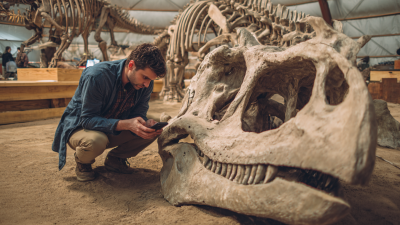How to Uncover the Secrets Behind Hidden Artifacts
Table of Contents
- Techniques for Identifying Hidden Artifacts in Historical Sites
- Using Technology to Enhance Artifact Discovery and Analysis
- Understanding Cultural Contexts to Locate Hidden Artifacts
- Collaborating with Experts: Building Networks for Artifact Research
- Documenting and Reporting Finds: Best Practices for Preservation
- Ethical Considerations in Artifact Unearthing and Handling
- FAQS
- Conclusion
- Related Posts
In the realm of archaeology, the quest to uncover "Hidden Artifacts" has captivated researchers and enthusiasts alike. According to a recent industry report from the Archaeological Institute of America, the demand for educational resources and toys that simulate archaeological exploration has surged by over over 30% in the past five years. As the world's fascination with history deepens, companies like Jinhua City Dukoo Toys Co., Ltd. have seized the opportunity to innovate in this niche market. Since 2009, Dukoo Toys has specialized in customizing archaeological products, catering to a diverse global clientele. The company has seen remarkable growth, expanding its factory from a modest 400 square meters to an impressive 8,000 square meters, reflecting a strong commitment to providing engaging and educational experiences centered around the discovery of hidden treasures from our past.

Techniques for Identifying Hidden Artifacts in Historical Sites
Identifying hidden artifacts at historical sites requires a combination of
advanced technology and
traditional archaeological techniques.
Ground-penetrating radar (GPR) has become an invaluable tool in this field,
with recent studies showing it can detect objects buried up to 25 meters deep
while maintaining a high level of detail. According to a 2022 industry report,
GPR usage has increased by 30% among archaeologists over the last decade,
reflecting its effectiveness in revealing concealed treasures without disturbing the site.
In addition to GPR, drone technology plays a pivotal role
in uncovering hidden artifacts. Equipped with high-resolution cameras and thermal imaging capabilities,
drones can survey large areas quickly, providing insights into the site’s topography and identifying
potential excavation zones. Research shows that the use of aerial surveys has enhanced the
identification process by up to 40%, enabling archaeologists to pinpoint
areas of interest with greater accuracy. By integrating these modern techniques with traditional
excavation methods, researchers can uncover the secrets behind hidden artifacts more efficiently
than ever before.
Using Technology to Enhance Artifact Discovery and Analysis
In the quest to uncover hidden artifacts, technology plays a vital role in enhancing discovery and analysis. Advanced tools such as ground-penetrating radar and drone mapping have revolutionized archaeological digs, allowing researchers to visualize and locate buried objects without invasive digging. These technologies not only save time and resources but also protect the integrity of historical sites.
**Tips:** First, consider investing in training for your team to ensure they can effectively use new technology. Understanding how to interpret data from devices like 3D scanners can lead to more accurate analyses of the artifacts uncovered. Second, combining traditional techniques with modern technology—like using GPS for precise mapping—can yield better results in your search efforts.
Moreover, software applications designed for analysis can help categorize and document findings efficiently. By employing machine learning algorithms, researchers can identify patterns in large datasets that may suggest previously unknown relationships among artifacts.
**Tips:** Always keep your software updated and engage with online resources and communities to stay informed about emerging technologies in artifact discovery. This collaboration can pave the way for innovative solutions and enhance the overall efficacy of your archaeological endeavors.

Understanding Cultural Contexts to Locate Hidden Artifacts
Understanding the cultural contexts of hidden artifacts is crucial for archaeologists and treasure hunters alike. Artifacts often carry historical significance that is deeply intertwined with the traditions, beliefs, and daily practices of ancient societies. When searching for hidden artifacts, it's essential to appreciate the cultural backdrop that led to their creation and eventual concealment. This understanding can guide researchers in identifying promising excavation sites, as certain artifacts are more likely to be found in locations that hold historical and cultural relevance.
Tips: One effective strategy is to dive into local history and folklore. Engaging with local communities can uncover stories and legends that may hint at the presence of hidden treasures. Additionally, studying environmental changes over time can provide clues about how people interacted with their surroundings and where artifacts might be hidden.
Another important aspect is the examination of trade routes and settlement patterns. Many artifacts were moved or lost along paths of commerce or in areas where civilizations thrived. By understanding these routes, you can better predict where artifacts might be located. Analyzing maps and historical accounts can be instrumental in this investigative process.
How to Uncover the Secrets Behind Hidden Artifacts
| Artifact Name | Cultural Context | Location Found | Estimated Age | Significance |
|---|---|---|---|---|
| Ancient Pottery | Mesoamerican Culture | Mexico | 1200 - 200 BC | Used in rituals and daily life |
| Bronze Sword | Roman Empire | Italy | 300 BC - 300 AD | Symbol of power and military skill |
| Ceremonial Mask | African Tribal Culture | West Africa | 20th Century | Used in cultural ceremonies and dances |
| Stone Tools | Early Human Culture | Eastern Africa | 2.5 million years ago | Tools used for hunting and gathering |
| Medieval Manuscript | Medieval Europe | England | 12th Century | Valuable historical texts for scholarly studies |
Collaborating with Experts: Building Networks for Artifact Research
Collaborating with experts is crucial for uncovering the mysteries of hidden artifacts. In today's interconnected world, building networks for artifact research can significantly enhance the quality and depth of studies. Multidimensional scientific networks allow researchers to efficiently share insights and methodologies, creating a more substantial foundation for understanding not just the artifacts themselves but also the cultural contexts surrounding them. Utilizing ontology-based graphs can facilitate this collaborative approach, providing structured frameworks for researchers to engage with one another and streamline the research process.
At Jinhua City Dukoo Toys Co., Ltd., we understand the importance of collaboration in bringing archaeological toys and products to life. Since our inception in 2009, we have focused on tailoring our offerings to meet the diverse needs of customers worldwide. Through partnerships with archaeologists and educational institutions, we are able to collect valuable feedback and insights, allowing us to innovate and improve our product line continually. As we expand from a small factory to a significant industry player, fostering collaboration and knowledge sharing remains at the core of our strategy to promote archaeological awareness.
Documenting and Reporting Finds: Best Practices for Preservation
Documenting and reporting finds is crucial in the world of archaeology and artifact preservation. When a hidden artifact is uncovered, meticulous documentation is the first step in respecting the integrity of the site and the object itself. This involves recording the precise location, context, and condition of the artifact. Use photographs taken from multiple angles, detailed sketches, and written descriptions to create a comprehensive record. Such documentation not only aids in future research but also assists in understanding the significance of the find within its historical context.
Once the find is documented, it’s essential to report the discovery to relevant authorities or institutions. Sharing information about the find helps ensure that it is preserved and studied appropriately. Best practices dictate that this report should include all documented details, alongside any interpretations or hypotheses regarding the artifact's use and origin. Engaging with professionals specialized in artifact preservation can also enhance the understanding of the item's importance and provide guidance on conservation techniques to protect it for future generations. By adhering to these best practices, we ensure that hidden artifacts are respected and preserved, allowing their stories to be told.
Ethical Considerations in Artifact Unearthing and Handling
Unearthing hidden artifacts is a thrilling endeavor, but it carries significant ethical responsibilities. The discovery process must prioritize the preservation of cultural heritage while respecting the rights of local communities. When excavating sites, archaeologists must consider the historical context and potential impact of their findings on indigenous cultures. Engaging with local populations and obtaining their consent is crucial to ensure that artifact handling aligns with their values and traditions, fostering a sense of ownership and collaboration rather than exploitation.
Additionally, once artifacts are uncovered, their treatment must adhere to ethical guidelines that prioritize conservation over commercial interests. This includes proper documentation, secure storage, and respectful display practices. Artifacts are not merely objects; they represent stories and identities. Thus, it is vital to engage with professionals and historians who can provide insight into their significance and context. By doing so, we honor the legacy of these artifacts and ensure that they are appreciated in a manner that promotes education and understanding, rather than commodification.

FAQS
: Understanding cultural contexts is crucial because artifacts often carry historical significance that is intertwined with the traditions, beliefs, and daily practices of ancient societies, guiding researchers to promising excavation sites.
Engaging with local communities can uncover stories and legends that may provide hints about the presence and location of hidden treasures.
Many artifacts were moved or lost along paths of commerce or in thriving areas. Understanding these routes helps predict where artifacts might be located.
Collaboration enhances the quality and depth of studies by allowing researchers to share insights and methodologies, creating a stronger foundation for understanding artifacts and their cultural contexts.
The company partners with archaeologists and educational institutions to collect feedback that informs and improves their products, showcasing the importance of collaboration in promoting archaeological awareness.
The discovery process must prioritize the preservation of cultural heritage, involve local communities' consent, and adhere to guidelines that favor conservation over commercial interests.
Engaging with local populations ensures that artifact handling aligns with their values and traditions, fostering collaboration rather than exploitation.
Proper documentation, secure storage, and respectful display practices are essential to honor the stories and identities represented by the artifacts.
Artifacts should be appreciated for their significance and context, promoting education and understanding over commercialization.
Analyzing maps, historical accounts, and environmental changes can provide valuable clues about how past societies interacted with their surroundings and the location of artifacts.
Conclusion
The exploration of hidden artifacts is a fascinating journey that combines innovative techniques and technology with a deep understanding of cultural contexts. By employing advanced identification methods, researchers can unveil hidden artifacts within historical sites, enhancing the process of discovery and analysis. Collaborating with experts and building networks is essential for effective artifact research, allowing for shared knowledge and insights. Furthermore, documenting and reporting finds ensures the preservation of these valuable items while ethical considerations guide the responsible handling of artifacts.
At Jinhua City Dukoo Toys Co., Ltd., we recognize the importance of hidden artifacts in enriching our understanding of history. As a leading manufacturer of archaeological toys since 2009, we aim to customize products that bring the excitement of artifact discovery to customers worldwide. Our dedication to promoting awareness of cultural heritage aligns with our growth from a small factory to an expansive facility, supporting the ongoing exploration and appreciation of hidden artifacts.
Related Posts
-

10 Essential Tips for Creating the Perfect Outdoor Dig Pit for Kids
-

7 Creative Tips for Maximizing Fun with Parent-child Educational Dig Toys
-

Ultimate Guide to Unleashing the Secrets of Your Crystal Mining Kit
-

How to Unlock the Secrets of Fossil Discovery Toy for Young Explorers
-

The Future of Interactive Dinosaur Bone Dig Experiences
-

Ultimate Guide to Sourcing Multi-Player Dig Adventure Games for Global Markets
Blog Tags:

